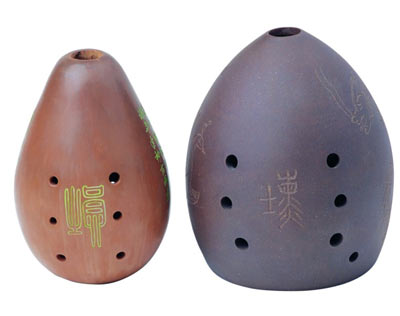 Xun
Xun
 The xun is one of the oldestmusical instrumentsin China, with a history of approximately 7,000 years.
The xun is one of the oldestmusical instrumentsin China, with a history of approximately 7,000 years.
It is said that the xun originated from the hunting tool of the stone meteor. During ancient times, people often tied a stone or mud ball to the rope that was used for hunting wild animals. The people would then throw the ropes, with the stones wrapping around the animal's limbs, bringing them down, Hence the name of stone meteor. Some of the balls were hollow, and so made many sounds when thrown. Most people found these hollow balls enjoyable and learned how to blow air into them. Gradually, the stone meteor became the musical instrument known as the xun.
The earliest xun was made of stone or bones, but later it became earthen. Also, the forms varied in many ways. For example, it could be shaped like a ball, a pear, a fish, or a flat circle or ellipse.
The xun is an egg-shaped, windpipe instrument. Initially it had only one hole, but afterwards it gained more holes. Finally at the end of the 3 century BC a six-holed model appeared.
Professor Caozheng from the Chinese Conservatory of Music has been trying to imitate the ancient earthen xun since the end of the 1930s .
Later, Professor Chenzhong at theTianjin Conservatory of Musiccreated a new version with nine holes. The new instrument not only has kept the original form and tones, but also has expanded its range and become louder. The nine holes are arranged in a free order, which is convenient for performing. Very soon, Zhao Liangshan, one of the professor's students from the Song and Dance Ensemble ofHubei Province, developed another new type with ten holes, which was suitable for alt (high octave) performances.
The xun instrument was usually used in making royal music in Chinese history. There are two kinds of xun. One is shaped like an egg (smaller but louder) and the other is often played along with another kind of pipe instrument called a chi, an ancient Chinese musical instrument that is made of bamboo. Some descriptions about the xun can be found in shijing, the earliest form of poetry in China.
